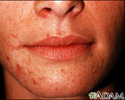Perioral dermatitis
Periorificial dermatitis
Perioral dermatitis is a skin disorder resembling acne or rosacea. In most cases, it involves tiny red bumps that form on the lower half of the face in the folds of the nose and around the mouth.
Causes
The exact cause of perioral dermatitis is unknown. It may occur after using face creams containing steroids for another condition.
Young women are most likely to get this condition. This condition is also common in children.
Periorificial dermatitis may be brought on by:
- Topical steroids, either when they are applied to the face on purpose or by accident
- Nasal steroids, steroid inhalers, and oral steroids
- Cosmetic creams, make-ups and sunscreens
- Fluorinated toothpaste
- Failing to wash the face
- Hormonal changes or oral contraceptives
Symptoms
Symptoms may include:
- Burning feeling around the mouth. The creases between the nose and mouth are most affected.
- Bumps around the mouth that may be filled with fluid or pus.
- A similar rash may appear around the eyes, nose, or forehead.
The rash may be mistaken for acne.
Exams and Tests
Your health care provider will examine your skin to diagnose the condition. You may need to have other tests to find out if it is due to a bacterial infection.
Treatment
Self-care you may want to try include:
- Stop using all face creams, cosmetics, and sunscreen.
- Wash your face with warm water only.
- After the rash has cleared, ask your provider to recommend a non-soap bar or a liquid cleanser.
DO NOT use any over-the-counter steroid creams to treat this condition. If you were taking steroid creams, your provider may tell you to stop the cream. They may also prescribe a less potent steroid cream and then slowly withdraw it.
Treatment may include medicines placed on the skin such as:
- Metronidazole
- Erythromycin
- Benzoyl peroxide
- Tacrolimus
- Clindamycin
- Pimecrolimus
- Sodium sulfacetamide with sulfur
You may need to take antibiotic pills if the condition is severe. Antibiotics used to treat this condition include tetracycline, doxycycline, minocycline, or erythromycin.
At times, treatment may be needed for up to 6 to 12 weeks.
Outlook (Prognosis)
Perioral dermatitis requires several months of treatment.
Bumps may return. However, the condition does not come back after treatment in most cases. The rash is more likely to return if you apply skin creams that contain steroids.
When to Contact a Medical Professional
Contact your provider if you notice red bumps around your mouth that do not go away.
Prevention
Avoid using skin creams containing steroids on your face, unless directed by your provider.
References
Dinulos JGH. Acne, rosacea, and related disorders. In: Dinulos JGH, ed. Habif's Clinical Dermatology. 7th ed. Philadelphia, PA: Elsevier; 2021:chap 7.
James WD, Elston DM, Treat JR, Rosenbach MA, Neuhaus IM. Acne. In: James WD, Elston DM, Treat JR, Rosenbach MA, Neuhaus IM, eds. Andrews' Diseases of the Skin: Clinical Dermatology. 13th ed. Philadelphia, PA: Elsevier; 2020:chap 13.
Review Date: 7/1/2023





